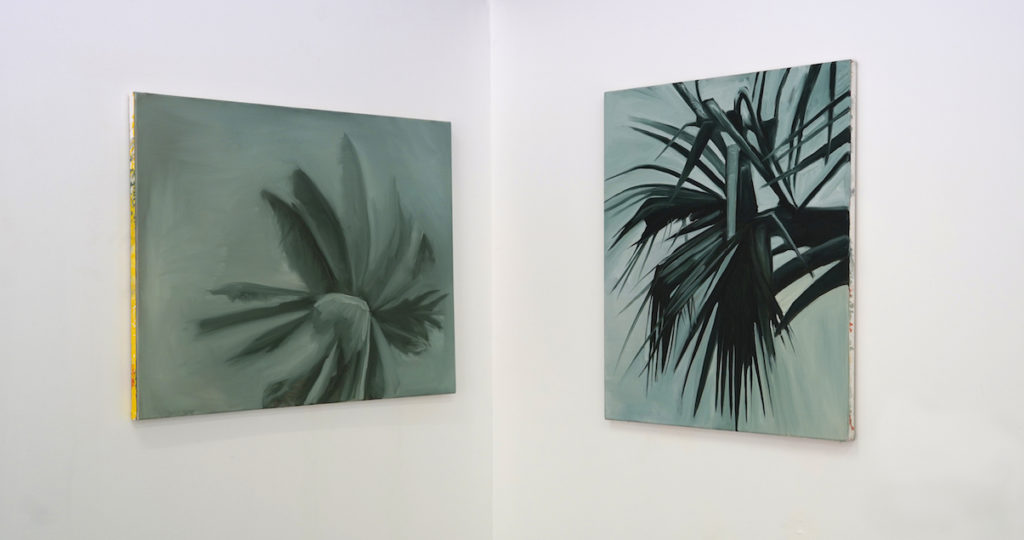Interview with Johann Milh on the occasion of his exhibition “Violet de France”, presenting an ensemble of recent works created following his artistic residency in India at the beginning of 2019.
How long was your stay in India?
Six weeks. From mid-December to mid-February.
Where was it exactly?
In the South of the country. In Hyderabad, the capital of the State of Telangana.
An important city?
By its population, it is the sixth largest city in India with 10 million inhabitants. It is very active in the high-tech industry. After Bangalore, it is the other Indian Silicon Valley, but it remains India, chaotic and anarchic with battered roads, no pavements, no real system of transportation. It is also called the City of Pearls.
Why is that?
Until the eighteenth century, India was the main diamond producer in the world. One of its main deposits was in the Golconda Sultanate, on Hyderabad’s current location. The opulence, pomp and wealth of the city were built on these natural resources. Most of the monuments from this era have domes with facets sculpted like diamonds.
Did you look into this diamond aspect further?
When doing research, I discovered that many mythical diamonds had been extracted from the Golconda mines. Namely Louis XIV’s blue diamond, also called French Blue, French Violet [Violet de France is the title of the exhibition] or Tavernier Blue, from the name of the French merchant who brought it back from India to sell it to Louis XIV. Stolen in 1792 with the French Crown Jewels, we then loose its trace. It appears again resized in the collection of a new owner, Thomas Hope, a banker and Enlightenment patron who donated it to the British Crown Jewels. Christened from then on the Hope, it is today in the National Museum of Natural History in Washington…
Actually, the story of Violet de France is fuelled by all sorts of fabulous stories, historical events, tragedies and curses that oppressed its different owners, starting with the legend of the diamond itself that states that the thief stole the rock on the statue of the Goddess Sitâ before being hit by lightning.
What interested you in the odyssey of this object?
The idea that this geological, almost astral compression was transformed into a sign of distinction and power… this distance between its nature and its cultural function, punctuated with all these incidents that have built its history and aura… It fascinated me. Actually, for me, it echoed my thoughts on painting, on the use of nature and the link we have with manufactured objects.
Can you develop?
Between diamonds and painting, there is an obvious parallel: an object in transit that circulates. For painting: from the workshop to the gallery, from the art centre to the museum, from the artist to the spectator, from the gallery manager to the collector. It is an organic object made of oil that goes beyond its own materiality. An object of projection, of fascination, of identification through which each and every one of us carries our imagination… as does the diamond.
Do you develop this mirror approach in the canvases you have created? For example, with the portrait of Thomas Hope?
Hope is an ambivalent character, a wealthy man, a patron and a humanist who bears the name hope, but who also purchased this diamond in a rather shady way. Rather than bringing up these aspects in a direct manner, I prefer using mirrors. The portrait I painted of Thomas Hope was done using a bust. To paint a sculpture is an idea that I liked, just as when I paint this gem. It recalls Violet de France without representing it. It is a natural rock, a stone, the image of a double, that can look like a chewing-gum as well as an astral jewel or something completely different. It is a source of light in the canvas, as well as being an object that absorbs the light. It is a filter, a surface, a depth, a phantom-like presence.
Like one of your recurring motifs, the palm tree?
For me, the palm tree acts as a logo, a symbol, something that is at once familiar, fascinating and exotic… it is actually quite a mysterious subterfuge. It looks like a tree but it is a plant. Visually, it is very contemporary, yet it is prehistoric. Structurally speaking, the leaves simulate a sort of explosion that falls instantly. I like this dimension between attraction and gravity, between fascination and repulsion… a sort of glorious desolation in short.
What actually interests you is detaching yourself from the source?
Yes. Painting what would be the idea of a palm leaf for example, rather than the palm leaf itself. There is always a story that escapes us, one can never grasp it in its entirety and it doesn’t matter because reality always embraces us more than we can apprehend it. I like to simultaneously combine different typologies; I make different subjects meet on the canvas that come from my own story or the collective story… These elements rub shoulders, are present without being visible. We feel them. We have to trust our intuition, because there isn’t a message, just the desire to create spaces of personal projection. I haven’t practiced graphic design that I studied for a while, because I want to escape from the authority of constructed images.
Interview by Anna Maisonneuve
Exhibition : Johann Milh, Violet de France, agence BAM projects
Artist’s website : Johann Milh








